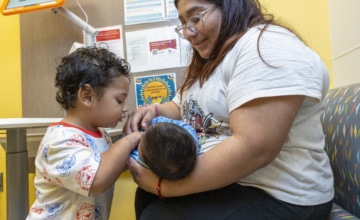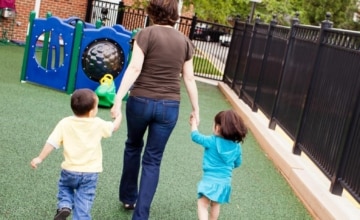Why do children whine?
- It’s the best they can do in the moment. Young children are not yet able to self-regulate very well (or calm their feelings and bodies so they can respond to stressors in appropriate ways). Sometimes whining signals when a child is beginning to lose control and needs an adult to help her calm down. What to do? Cuddle your child and offer gentle comfort to help her begin to regulate.
- Toddlers don’t have the words they need. Young children often lack the words to communicate their feelings and needs (I’m sad about sharing or I’m too warm in this sweater!). Whining is sometimes a child’s best effort at communication. What to do? Take a moment to be a detective—what might the whining mean? Look for the child’s need and try to meet it. Then model what he can say to have his needs met in more acceptable ways.
- They are overwhelmed or run down. Children often whine when their emotional gas tank is on empty. Think about the last time your child ate or slept (and offer one or both). Did she have a tough day? Has she been dealing with a lot of changes lately? What to do: Offer soothing. A child who is overwhelmed needs compassion and a parent’s help to feel calm again.
Whining can get us charged up. It always helps if we calm ourselves before responding. Take a deep breath and then act. If whining is at an all-time high (when your child is between 2 and 4 years old), you may need some additional strategies:
- Name your child’s feelings. People can’t be talked out of what they feel. It works much better to recognize their experience. By naming how children are feeling, we let them know we see and understand. (This is true even when his upset seems silly to us—like having to wear his panda shirt instead of his striped shirt.) A parent might say, “You are feeling sad. You wanted your striped shirt today, and it’s dirty. That’s hard.”
- Get closer and offer comfort. Children need to feel close and connected to their parents and caregivers to function well. Often, getting closer to a whining child can calm her. This doesn’t mean that you are “giving in.” It means you are a great parent who is giving your child what she needs: “Your voice tells me you might need a snuggle.”
- Try a silly game, a distraction, or a choice. Use a funny voice, pretend to be a rabbit, or do some silly fake sneezes. Distract a child by pointing to the garbage truck outside. Or offer a choice: “No cookies, but would you like cheese or a banana?” These little tricks can sometimes shift a child’s mood.
- Change the story you’re telling yourself. So often we hear whining and judge our child’s behavior (as spoiled or demanding). But the way we see a behavior shapes how we respond to it. The truth is that whining is completely normal for toddlers. Knowing this behavior is normal, we can respond from a place of compassion instead of from a place of anger and frustration.
And one important strategy to use when your child isn’t whining: Pay attention to the times when your child is able to express a need without whining: “You were hungry and asked for a snack in a calm and kind voice—thank you!” or even someday: “Thanks for keeping your cool when I said ‘no.’”




